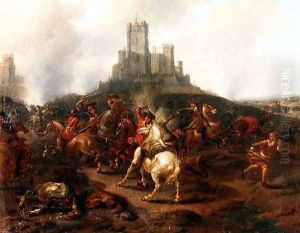Jan van Huchtenberg Paintings
Jan van Huchtenberg was a Dutch painter and engraver, primarily known for his works depicting horses and battle scenes. Born in Haarlem in 1647, he became part of the Northern Netherlands' rich tradition of art and painting. He was initially influenced by his older brother, Jacob van Huchtenburg, who was also a painter, although not as well-known as Jan.
Jan van Huchtenberg's early career is not well-documented, but it is known that he moved to Amsterdam, where he became a pupil of the famous battle painter Adam Frans van der Meulen. Under the guidance of van der Meulen, van Huchtenberg developed his skills in painting cavalry and battle scenes, which would become his hallmark. His works often depicted the glory and drama of warfare, with meticulous attention to detail in the representation of horses, soldiers, and the chaos of battle.
In the late 17th century, van Huchtenberg travelled to Rome, where he was exposed to the Italian masters and further honed his craft. Upon returning to the Netherlands, he settled in Amsterdam and established himself as a prominent painter of military scenes. His reputation grew, and he was eventually appointed court painter to the Elector Palatine, a position that allowed him to gain significant recognition and financial stability.
Throughout his career, van Huchtenberg also collaborated with other artists, including his brother and the landscape painter Philips Wouwerman. He often painted the figures and animals in the compositions of other artists, showcasing his expertise in these areas.
Jan van Huchtenberg's legacy lies in his contribution to the genre of battle painting. His works are characterized by their dynamic composition, vivid detail, and the sense of movement he was able to impart to his depictions of horses and soldiers. His paintings are valuable historical documents, providing insight into the military attire and tactics of the period.
Jan van Huchtenberg passed away in 1733. His works continue to be appreciated for their artistic merit and historical significance, and can be found in various museums and private collections around the world.
